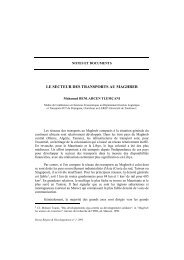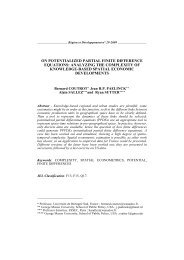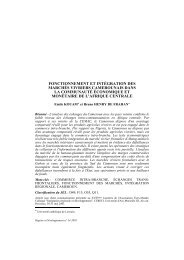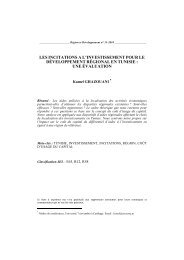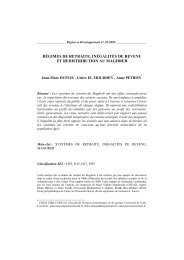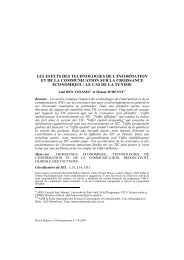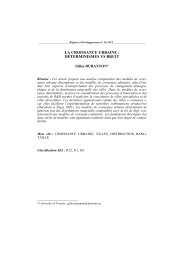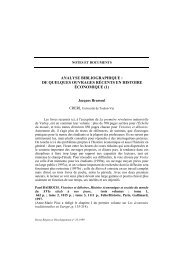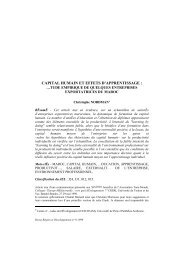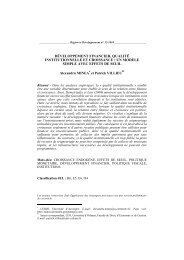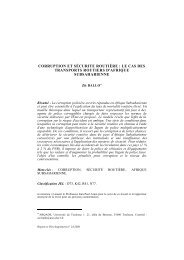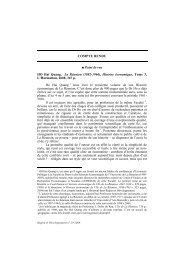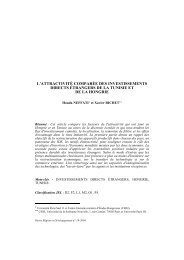space and growth: a survey of empirical evidence ... - ResearchGate
space and growth: a survey of empirical evidence ... - ResearchGate
space and growth: a survey of empirical evidence ... - ResearchGate
You also want an ePaper? Increase the reach of your titles
YUMPU automatically turns print PDFs into web optimized ePapers that Google loves.
32 Maria Abreu, Henri L.F. de Groot <strong>and</strong> Raymond J.G.M. Floraxsystem, so that the spatial effects in the model are global in nature. Second, the−1induced effects cause the diagonal elements <strong>of</strong> the matrix (1 − ρW ) β to beunequal to β.The total effect <strong>of</strong> an increase in x is the sum <strong>of</strong> the direct, indirect <strong>and</strong>induced effects. The direct effects are not region-specific <strong>and</strong> are represented bythe estimated coefficient β. The indirect effects depend on the spatial orderingimplied by the weights matrix <strong>and</strong> are typically region-specific. The inducedeffects are region specific as well. It is therefore incorrect to compare thecoefficient β <strong>of</strong> the spatial lag model with the coefficient β in an OLS model,since the first represents only the direct marginal effect <strong>of</strong> an increase in x, whilethe second represents the total marginal effect.The column sum <strong>of</strong> the elements <strong>of</strong> the spatial multiplier matrix for regioni represents the total effect in all regions j <strong>of</strong> an exogenous shock in region i,while the row sum for region i represents the total effect on region i <strong>of</strong> asimultaneous shock in all regions j. Typically the former are region-specific,whereas the latter are not. Hence the magnitude <strong>of</strong> the impact <strong>of</strong> the shockdepends on where it occurs.This heterogeneity in the total effects can be exploited when constructingthe model. For example, we may be interested in the impact that improvingproperty rights in one country has on other countries in the region. The spatialeconometrics literature has tended to focus on a rather technical interpretation <strong>of</strong>the results, while it could be providing interesting policy implications.93.2.2. Distinction between global <strong>and</strong> local effectsThe spatial econometrics literature has tended to focus on the structuralform <strong>of</strong> the spatial lag <strong>and</strong> spatial error models, in which the spatial lag terms(Wy, Wx, Wε) appear directly on the right-h<strong>and</strong> side <strong>of</strong> the model. As we haveseen in the previous section, failure to consider the model in its reduced form canlead to problems in interpreting the estimated coefficients. As with the spatial lagmodel, the spatial effects captured by the spatial error model are global in thesense that a shock at any location will be transmitted to all other locationsfollowing the spatial multiplier process (Anselin, 2002).The over-reliance <strong>of</strong> the literature on the spatial error <strong>and</strong> spatial lagmodels has tended to obscure other models available to capture spatial effects.One possibility is the spatial cross-regressive model, which consists <strong>of</strong> includingthe spatial lag <strong>of</strong> one or more explanatory variables on the right h<strong>and</strong> side. Anexample is Lall <strong>and</strong> Yilmaz (2001), who include the spatial lag <strong>of</strong> human capital9 See also Easterly <strong>and</strong> Levine (1998) for a non-technical discussion on the spatial multiplier, froma non-spatial econometrics point <strong>of</strong> view.




